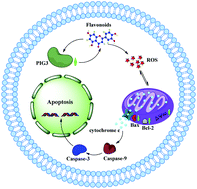The p53-inducible gene 3 involved in flavonoid-induced cytotoxicity through the reactive oxygen species-mediated mitochondrial apoptotic pathway in human hepatoma cells
Abstract
Flavonoids have been reported to exhibit prooxidant cytotoxicity against cancer cells, but the underlying mechanism is still poorly understood. Here we investigated the potential mechanism that p53-inducible gene 3 (PIG3), a NADPH:quinone oxidoreductase, mediated the prooxidant cytotoxicity of flavonoids on human hepatoma HepG2 cells. The results showed that flavonoids (apigenin, luteolin, kaempferol, and quercetin) inhibited the growth of HepG2 cells in a dosage- and time-dependent manner, and induced the morphological changes characteristic of apoptosis in HepG2 cells. We also found that expression of PIG3 was increased markedly in HepG2 cells treated with flavonoids at both mRNA and protein levels, which was accompanied by increased intracellular ROS production and a decreased mitochondrial membrane potential (ΔΨm). All these effects were largely reversed through knockdown of the PIG3 gene in HepG2 cells. Western blotting indicated that flavonoids increased cytochrome c release, upregulated the ratio of Bax/Bcl-2, and activated the caspases-9 and -3. Moreover, knockdown of PIG3 could reverse the changes of these apoptotic-related proteins. These results suggest that PIG3 plays an important role in regulating the prooxidant activity and apoptosis-inducing action of flavonoids on HepG2 cells though the ROS-triggered mitochondrial apoptotic pathway.


 Please wait while we load your content...
Please wait while we load your content...